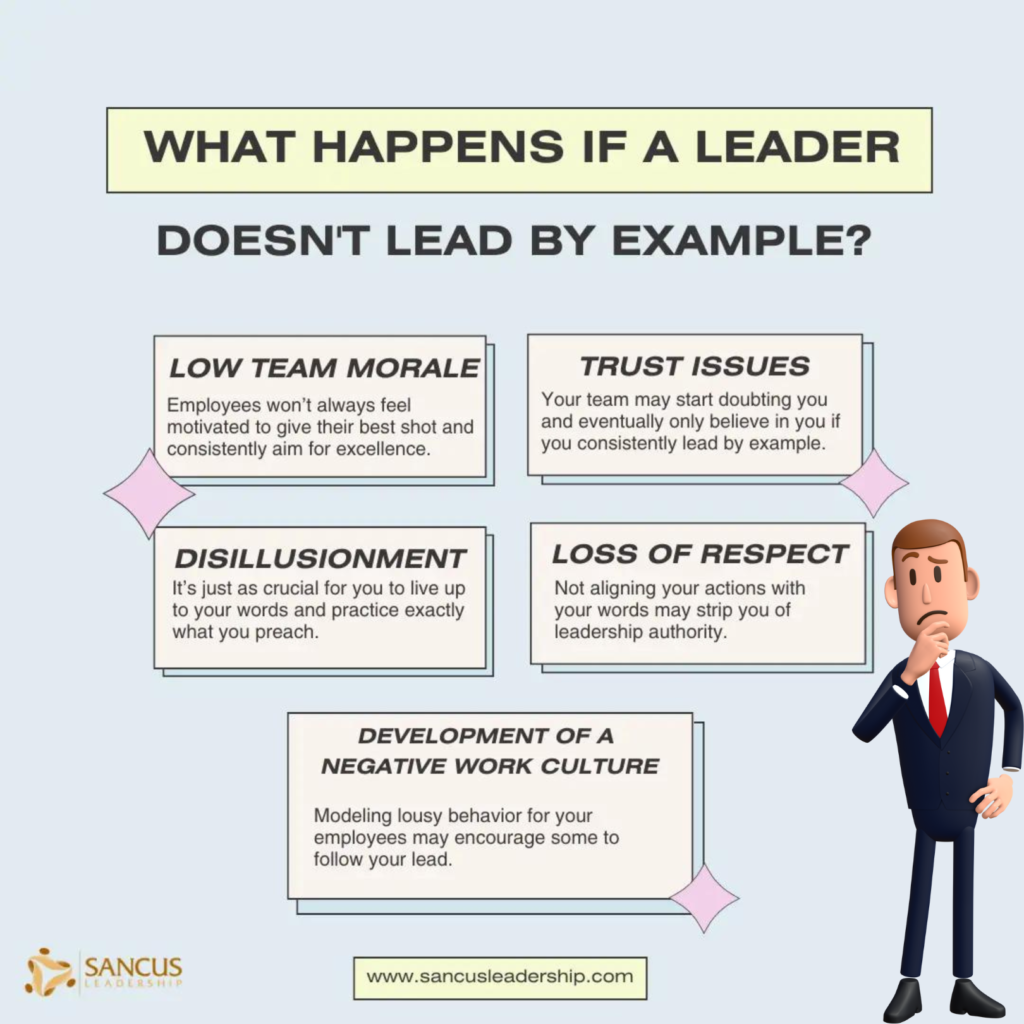There is probably nothing more off-putting and dispiriting than a leader who doesn’t lead by example. You’ll likely find their team members cynical, passive, and without much enthusiasm for their work. This is disastrous for any business because it directly affects productivity and growth.
When leaders don’t lead by example, their employees feel betrayed, deceived, apprehensive, and unsettled. It creates a hostile work culture where the team is uninspired, disillusioned, and unwilling to cooperate. It paves the way for employees to lose trust, respect, and deference to their leader.
When leaders don’t lead by example, their employees feel betrayed, deceived, apprehensive, and unsettled.
Stick around to discover what happens when a leader fails to lead by example and how it can adversely affect team dynamics. We will talk about the impact of needing someone on the team they can look up to, emulate, and be proud of, leading them to feel uninspired about work, unwilling to collaborate with you and their teammates, and disinclined to excel. I will also give tips on what to do to ensure you’re always a good role model for your team.
Should Leaders Always Lead by Example?

Leaders should always lead by example since this is a great way to earn your team members’ trust, respect, and loyalty. When you walk the talk, you motivate your employees to push forward toward your shared visions and goals enthusiastically. You inspire them to emulate you and adhere to the same standards and ethics you embrace.
Leaders should always lead by example since this is a great way to earn your team members’ trust, respect, and loyalty.
Leaders sometimes mistakenly assume that, due to their ranking in the business, they are exempted from scrutiny and estimation, especially from their subordinates. They presume they can do their tasks without considering how they impact their employees. They focus only on ensuring that tasks are accomplished, the team stays on track, and objectives are promptly achieved.
This tunnel vision is highly detrimental to team dynamics and productivity. Your employees will feel betrayed. They will eventually lose their trust and respect for you, and anger, doubts, and suspicions will replace these.
Let’s take a closer look at what can happen if a leader doesn’t lead by example:
Low Team Morale
A friend used to head a small software development team. He knew little about the technicalities of coding and programming, but he believed he possessed the critical traits expected of a proficient leader (and so did management; thus, they promoted him).
Employees won’t always feel motivated to give their best shot and consistently aim for excellence. Effectively leading a team means finding ways to bring out the best in people so they grow their skills, enhance their experiences, and become valuable assets in the business. When team morale is low, your employees will not be keen on achieving their full potential.
Effectively leading a team means finding ways to bring out the best in people so they grow their skills, enhance their experiences, and become valuable assets in the business.
He was doing great at the start, but when his team started working more synergistically and productively, his leadership effectiveness must’ve somehow gone to his head, and he became a different person altogether.
For instance, he has constantly reiterated the value of offering aftermarket services to their clients. Still, he began to handle even the most loyal clients by ignoring and sometimes mocking their requests for software operations and maintenance assistance. His team noted how he would frequently say one thing in front of them, only to cancel out his words by doing the opposite.
My friend lost his team’s respect and loyalty. Management caught wind of it, especially since his lousy behavior became evident in how his team’s productivity plummeted. Some employees followed his lead and adopted a more passive stance, adversely affecting team collaboration and efficiency. My friend was relegated to a leadership trainee position, but I must say that this was an enlightening experience for him.
Trust Issues
Your team may start doubting you and eventually only believe in you if you consistently lead by example. When you say one thing yet do another, you tell them you’re not fully invested in the team. It shows you’re not an authentic leader they can trust and count on to always do what’s best for the business.
Returning my displaced friend, he could not foster loyalty, respect, and trust in his team by not actively demonstrating his words. His behavior created doubts in his team’s minds about his true intentions and ethical standards. His team reacted, unsurprisingly, by mirroring his lack of drive, duplicity, and dishonesty.
Disillusionment
As a leader, remember that practically everything you do and say can serve as a precedent for your team. That’s why it’s essential to always model exemplary behavior and set good examples that your team can emulate. It’s not enough for you to encourage your team members to embrace high standards and good ethics. It’s just as crucial for you to live up to your words and practice exactly what you preach.
As a leader, your team is expected to look up to you as someone they can admire and be proud of. Failing to lead by example shows your team that you’re not the kind of leader they hoped you would be. Disillusionment and disappointment can adversely affect team motivation, directly affecting productivity.
Loss of Respect
Not aligning your actions with your words may strip you of leadership authority. When you fail to lead by example, your team may eventually lose respect for you and start seeing you as someone unworthy of their approbation and compliance.
This creates significant issues when you provide directives you expect your team to uphold. You might find them resisting your authority simply because they feel you don’t deserve it. Their lack of deference to you will also create problems when you attempt to resolve conflicts. You’ll be met with defiance because they deem you unfit for your leadership role.
Development of a Negative Work Culture
Modeling lousy behavior for your employees may encourage some to follow your lead. It may lead to a vicious cycle of employees emulating you, then you attempting to correct them and then refusing to submit due to a lack of trust and respect for you. These negative actions, ways of thinking, and outlooks may soon become entrenched in the work culture and become habits that will be hard to break.

Tips on How To Lead by Example
Leading by example is crucial to becoming an effective leader. You must be a good role model for your team, someone they can admire and aspire to be. This is one of the simplest ways you can inspire them to excel, deliver outstanding results, and tap into their full potential.
Here are some tips on how you can lead by example:
- Stick to your word. Always stand by your statements, keep your promises, and deliver your commitments. This inspires your team to follow your lead, allowing you to create an engaged, driven, and ambitious team.
- Walk the talk. You create an inclusive work environment by consistently actively demonstrating the behaviors, mindset, and ethics you claim you stand for. Only expect something from your employees that you are willing to do.
- Think before you speak. Don’t bite off more than you can chew. Ensure you can always translate into actions whatever statements you share with your team.
- Remember, no one is above the law. Leading a team doesn’t make you immune to scrutiny, rules, and expectations. At Sancus Leadership, we believe in establishing a culture of accountability within your team by ensuring you’re always the first to exhibit ownership of your words and actions.
- Be a team player, not just their coach. Managing a team means you must set the standards to which your team will adhere. Consistently demonstrate efficiency, collaboration, and excellence by actively leading your team and not just barking out orders from the sidelines. This is also a great way to boost your business’ employee retention rate.
| How to lead by example | Description |
| Stick to your word | Always honor your statements, promises, and commitments to inspire and lead your team. |
| Walk the talk | Actively demonstrate the behaviors, mindset, and ethics you expect from your team members. |
| Think before you speak | Ensure that your statements can be translated into actions and that you can follow through on what you say. |
| Remember, no one is above the law | Establish a culture of accountability by taking ownership of your words and actions as a leader. |
| Be a team player, not just their coach | Lead by example, actively participating and collaborating with your team rather than just giving instructions. |
Here’s a quick video that shows how leading by example is the most powerful way to influence those around you and how it can change the behavior of others more effectively.
Final Thoughts
When leaders don’t lead by example, their team may feel betrayed, disillusioned, and uninspired. They will lose their employees’ trust and respect, making it more difficult for them to manage the team effectively.
The best leaders lead by example and are excellent role models that their team can emulate and be proud of. Their ability to translate their words into actions is evident in their leadership brand. They know this is one of the best ways to encourage their team members to adopt great work ethics, always aspire for excellence, and contribute significantly to the business.



